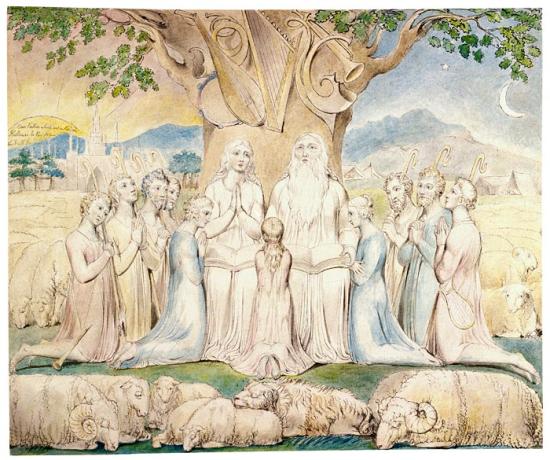
Job and His Family
Purchased by Pierpont Morgan, 1903
William Blake (1757–1827) occupies a unique place in the history of Western art. His creativity included both the visual and literary arts. In his lifetime he was best known as an engraver; now he is also recognized for his innovative poetry, printmaking, and painting. Blake's keen perception of the political and social climate found expression throughout his work. His strong sense of independence is evident in the complex mythology that he constructed in response to the age of revolution.
Blake was already recognized as an engraver at age twenty-five, when his first volume of poems appeared. At thirty-three, in The Marriage of Heaven and Hell, he audaciously claimed that his birth had marked the origin of a "new heaven" in which his own art would exemplify the creativity prefigured by Milton and Michelangelo. By that time, Blake, in one of his most productive periods, had already produced Songs of Innocence and was at work on a series of illuminated books. In 1818 he met John Linnell, a young painter and engraver, through whom a group of young artists became Blake's followers. Calling themselves the Ancients, they helped perpetuate Blake's influence for generations.
The Morgan's Blake collection—one of this country's most distinguished—began with purchases as early as 1899 by Pierpont Morgan. During the tenure of Charles Ryskamp, director from 1969 to 1986, major gifts almost doubled the size of its Blake holdings. In recent years Ryskamp's own gifts of engravings, letters, and related materials have significantly enriched its scholarly resources.
III. The Book of Job
These watercolors constitute Blake's first set of illustrations for the Book of Job, which the artist produced between 1805 and 1810 for his most important patron, Thomas Butts, plus two (plates 17 and 20) that he added after 1821 when he borrowed the set to copy for John Linnell.
The story of Job is of a good man sorely tested in order to understand the relationship between the evil of suffering and the existence of God. In Blake's version, Job's major flaw is attending to the letter, rather than the spirit, of God's law. In doing so, Job falls under Satan's spell and his suffering progresses into the horrible vision of a cloven-hoofed demon in the eleventh plate, Job's Evil Dreams. Elihu and Eliphaz, two of Job's friends, express particular arguments regarding his unidentified sin; however, his constant faith in God prevails. The remaining plates recount Job's spiritual growth— including the image where God shows him the Behemoth and Leviathan, the monsters of earth and sea—culminating in his family's celebration in the final image.
All drawings in pen and black ink, gray wash, and watercolor, over traces of graphite
Purchased by Pierpont Morgan, 1903; 2001.63–83
This online exhibition is presented in conjunction with the exhibition William Blake's World: "A New Heaven Is Begun" on view September 11, 2009, through January 3, 2010.
This exhibition is made possible through the generosity of Fay and Geoffrey Elliott.
